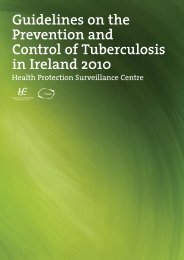Guidelines for the Early Clinical and Public Health Management of ...
Guidelines for the Early Clinical and Public Health Management of ...
Guidelines for the Early Clinical and Public Health Management of ...
You also want an ePaper? Increase the reach of your titles
YUMPU automatically turns print PDFs into web optimized ePapers that Google loves.
<strong>Guidelines</strong> <strong>for</strong> <strong>the</strong> <strong>Early</strong> <strong>Clinical</strong> <strong>and</strong> <strong>Public</strong> <strong>Health</strong> <strong>Management</strong> <strong>of</strong> Bacterial Meningitis (including Meningococcal Disease)<br />
Technique <strong>for</strong> obtaining throat swab<br />
• Using a full sweep <strong>of</strong> <strong>the</strong> pharyngeal wall <strong>and</strong> tonsils from all patients<br />
• If not possible, obtain a pernasal swab rotated on <strong>the</strong> posterior pharyngeal wall<br />
Figure 6.1. Sites <strong>for</strong> taking throat swabs<br />
Eye swabs<br />
In individuals with clinical signs suggestive <strong>of</strong> invasive meningococcal disease eye swabs may provide <strong>the</strong> only isolate<br />
<strong>of</strong> N. meningitidis <strong>and</strong> <strong>for</strong> such cases this finding is used to define <strong>the</strong> individual as a ‘presumed’ case.<br />
Cultures from non-sterile sites may provide <strong>the</strong> only source <strong>of</strong> isolate that can be used <strong>for</strong> strain differentiation <strong>and</strong><br />
susceptibility testing, <strong>and</strong> although <strong>the</strong>oretically may not be <strong>the</strong> disease causing strain is likely to be so in most<br />
cases.<br />
Polymerase chain reaction (PCR)<br />
PCR testing is now commonly used to rapidly diagnose IMD. PCR tests may increase <strong>the</strong> laboratory diagnosis <strong>of</strong><br />
cases <strong>of</strong> meningococcal disease by more than 30% <strong>and</strong> meningococcal DNA in CSF samples has been detected up<br />
to 96 hours after commencement <strong>of</strong> antibiotic treatment. PCR testing <strong>of</strong> blood <strong>and</strong> CSF has a high sensitivity <strong>and</strong><br />
specificity.<br />
At <strong>the</strong> IMMRL, an initial meningococcal specific real-time PCR screening assay is per<strong>for</strong>med followed in <strong>the</strong> case<br />
<strong>of</strong> positives samples by a specific serogrouping PCR assay. The target gene <strong>of</strong> <strong>the</strong> initial meningococcal PCR<br />
assay employed is <strong>the</strong> ctrA gene which encodes <strong>for</strong> a highly conserved outer membrane protein (OMP) involved<br />
in <strong>the</strong> transport <strong>of</strong> capsular polysaccharide. The second/subsequent PCR assay is a real-time serogrouping assay<br />
which will amplify serogroup specific sequences within <strong>the</strong> siaD gene which encodes <strong>the</strong> gene responsible <strong>for</strong> <strong>the</strong><br />
polymerisation <strong>of</strong> sialic acid to <strong>the</strong> polysialic acid chain. This assay will distinguish between serogroups B, C, Y <strong>and</strong><br />
W 135<br />
. Additional PCR tests <strong>for</strong> 29E, A <strong>and</strong> X can be per<strong>for</strong>med if required.<br />
The samples <strong>of</strong> choice <strong>for</strong> meningococcal PCR are blood (in an ethylenediamine - tetraacetic acid (EDTA) - containing<br />
tube) or uncentrifuged CSF.<br />
Positive DNA extracts <strong>and</strong> isolates received are stored at -80 0 C <strong>and</strong> may be porA sequence typed <strong>for</strong> variable regions<br />
1, 2 <strong>and</strong> 3 which has in many cases yielded in<strong>for</strong>mation on circulating strains <strong>and</strong> strain relatedness.<br />
There are no definitive studies on <strong>the</strong> sensitivity <strong>and</strong> specificity <strong>of</strong> PCR assays from skin lesions.<br />
Serodiagnosis<br />
Serological testing, based on an enzyme immunoassay using outer membrane proteins as <strong>the</strong> antigen, was<br />
developed by <strong>the</strong> UK PHLS Meningococcal Reference Unit (MRU). This methodology is not routinely done in Irel<strong>and</strong><br />
but if required can be requested by IMMRL, in which case samples are sent to SMPRL Stobhill Glasgow. The test has<br />
a sensitivity in excess <strong>of</strong> 97% in adults <strong>and</strong> older children (4 years or older) <strong>and</strong> reactions compatible with a recent<br />
meningococcal infection are a positive IgM test in a single sample or seroconversion if paired sera are available. IgM<br />
reaches diagnostic levels about 5–7 days after onset, although <strong>the</strong> precise onset <strong>of</strong> invasive meningococcal disease is<br />
<strong>of</strong>ten difficult to determine.<br />
Polysaccharide antigen testing<br />
Polysaccharide antigen testing may be used to demonstrate meningococcal polysaccharide antigen in CSF. However,<br />
-55-

















